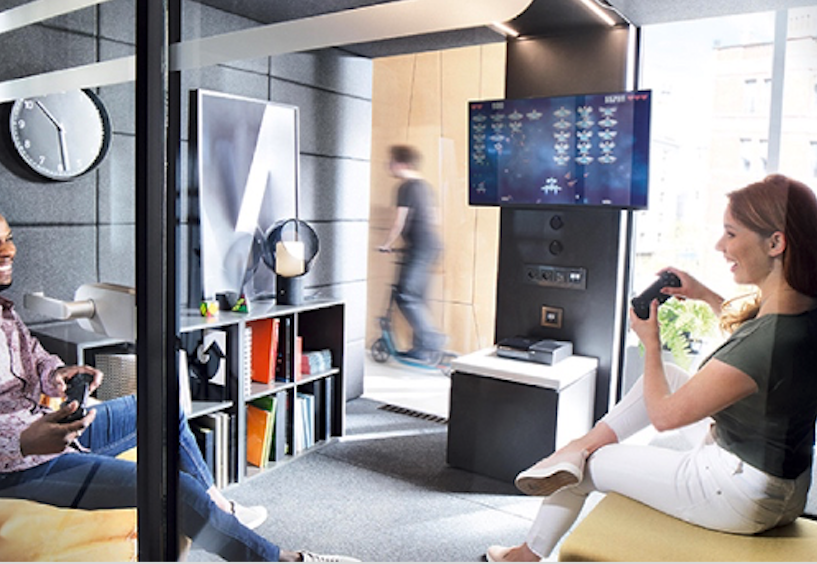PLASTARC explores how acoustic pods can help employees returning to the office adapt and customize their surroundings.
Many people spend the majority of their waking hours at work. It’s therefore no stretch to say that workplace design—and its effect on occupants—is a matter of public health. In fact, research has shown that workplaces that provide variety through the built environment may confer physical and psychological benefits to employees. There is also evidence that pairing flexible design with complementary practices like activity-based working (ABW) can facilitate wellness. The key mechanism lies in empowering individuals to seek out the spaces that meet their needs.
This people-centric approach has the advantage of appealing to a talent pool that is increasingly applying a consumer mindset to workplace experience. In other words, across industries, workers are placing a premium on personalization, agility, and technological sophistication. This trend is particularly pronounced following the lengthy periods of teleworking necessitated by the COVID-19 pandemic.
As employees are urged to reenter the office, they will bring with them expectations regarding the adaptability and customization of their surroundings given the ease with which alterations can occur at home. Fortunately, there exists an innovative product range that is uniquely poised to respond to these demands. Often referred to as “acoustic pods” or “mobile phone booths,” these freestanding structures generate privacy by dampening incoming and outgoing sound. A wide spectrum of models is differentiated by factors such as square footage, degree of enclosure, and integrated amenities. As a result, users can select the workstation best suited for a specific task, whether that is making a confidential call, leading a collaborative brainstorming session, or simply enjoying a pause from work altogether. The optionality inherent to this workspace concept can thus boost well-being by fostering a sense of agency (control over one’s life and decisions) and autonomy (capacity for self-direction).

ACOUSTICS
Due to their transformational nature, acoustic pods equip people with tools to manage their own sensory input over the course of the day. Individual differences are of significance here—what may serve as energizing stimuli for one person can be undermining to the focus of another. This is especially true as it relates to sound. When exposed to uncontrollable background noise, the body releases stress hormones like adrenaline and cortisol, which quickly tax the nervous system. Phone booths can alleviate some of these burdens by acting as quiet escapes from the communal hustle and bustle. Better yet, studies indicate that exerting ownership over one’s circumstances at work can lead to boosts in desirable behaviors like productivity and prosociality as well as to mental states that engender feelings of purpose and belonging.
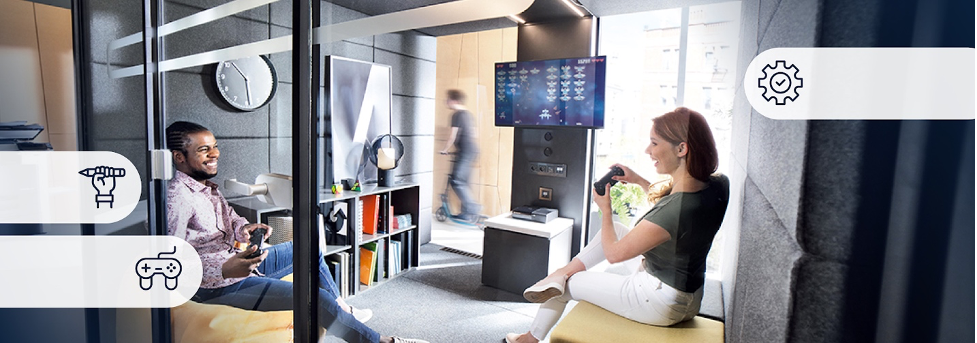
CREATIVITY
While a traditional office configuration might be imaginatively stifling to some, an acoustic pod-driven set-up—combined with an organizational culture that nurtures experimentation and exploration—can promote environments conducive to creative thinking. Psychologists, in turn, have found that employees who are encouraged to develop and demonstrate their creativity in the workplace enjoy a host of positive outcomes, ranging from better relationships with coworkers to higher job satisfaction.
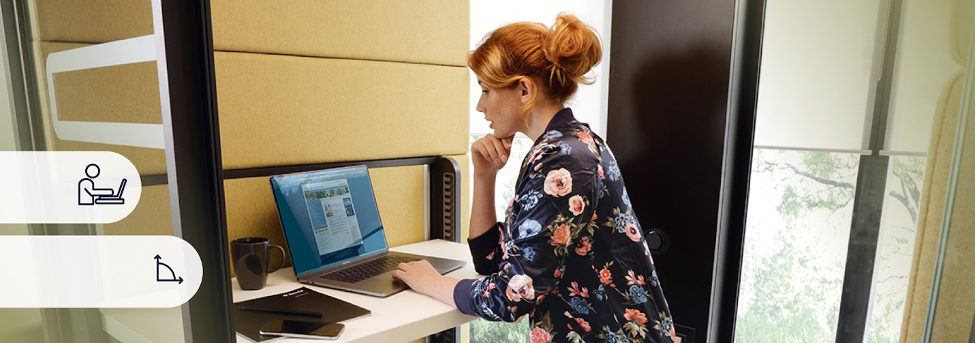
ERGONOMICS
The “well” office must also prioritize ergonomics—taking into account people’s abilities and limitations—in an attempt to mitigate sources of musculoskeletal discomfort. This is an area of strength for phone booths, which contain built-in furnishings that can be adjusted for height, weight, and intended posture. Ready access to fixtures like dimmable LED bulbs, USB power modules, and Bluetooth speakers can further guard against eye, neck, back, and shoulder pain by reducing straining, squinting, and the need to transfer gear from one spot to the next.

MOVEMENT
Ideally, people are able to do at least a bit of walking in the workplace as they navigate from one place to another. Even brief episodes of movement are of tremendous value health-wise when considering that a sedentary lifestyle—marked by excessive sitting and minimal exercise—is a risk factor in the expression of a multitude of chronic illnesses, ranging from diabetes to obesity to depression. When the fluid shifting of individuals is matched with furniture that is equally mobile, a truly dynamic office space can emerge. This absence of location-based constraints breeds possibility for everything from novel encounters with colleagues to sparks of inspiration.
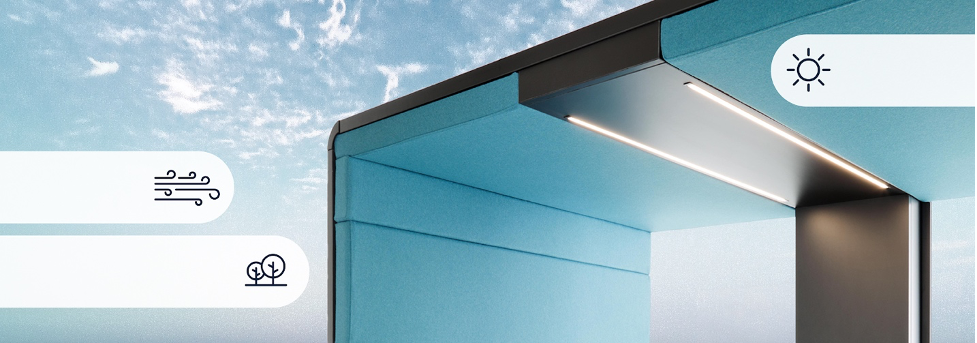
VENTILATION & ILLUMINATION
We know that lighting and air conditioning impact people differently depending upon age, gender, and underlying medical conditions. The consequence is that one-size-fits-all default settings tend to accommodate a narrow subset of the population at the expense of others. One way to solve for this is through a mix of presence and motion sensor-activated ventilation and illumination features. Upon entering a pod, for instance, fans and lights often engage at a fixed percentage of their maximum power and can then be calibrated according to personal preferences. Though these systems run only when triggered by occupants, they continually carry out internal air exchanges to maintain circulation while removing pollutants—a process that ensures the welfare of everyone in the vicinity.

HYGIENE
Sanitization is, of course, a common topic of concern for those preparing to return to the workplace. After all, colocation requires employees to routinely share surfaces, thereby potentially passing germs to one another. Ramped up cleaning protocols will play an important role in allaying some of these worries. Even so, there is a longer-lasting solution, one that involves thinking outside—or, in this case, inside of the box: revamping workstations to incorporate materials with antimicrobial properties, such as those utilized in the manufacturing of phone booths. In addition to eliminating pathogens in the forms of viruses, fungus, and molds, workplaces can take steps to enhance employee health through what they add to the environment. Plants, for example, not only battle toxins but can flush indoor spaces with fresh oxygen, act as radiation-absorbers, and simply, elevate the moods of those looking at them.
Understanding the mind-body connection—how they interact and how to support them both—is essential to successful human-centered design. It certainly motivated the vision for Hushoffice and other brands, whose offerings are informed by each of these dimensions of wellness. While that term may be a composite of countless physical and psychological elements, there is one contributor that cuts across time and place, and that is choice.
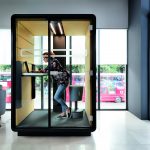 WDM editors have rounded up a list of the latest phone booths and privacy pods offerings to help transition employees who crave a quiet place for a call or heads-down work, among open plan spaces. We’ve even captured their air quality stats, connectivity options, sustainability stories and the all important installation times!
WDM editors have rounded up a list of the latest phone booths and privacy pods offerings to help transition employees who crave a quiet place for a call or heads-down work, among open plan spaces. We’ve even captured their air quality stats, connectivity options, sustainability stories and the all important installation times!

